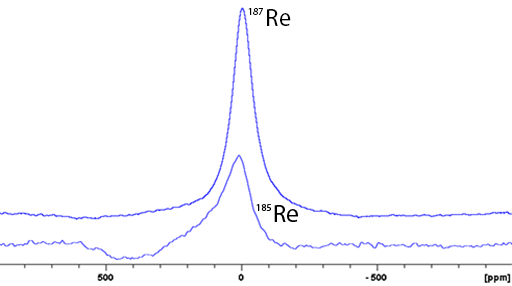(Re) Rhenium NMR
Use our NMR service that provides Re NMR and many other NMR techniques.
Rhenium (Re) has two medium sensitivity NMR active nuclei, 185Re and 187Re. 187Re is more sensitive and yields less broad signals than 185Re (fig. 1). 187Re is therefore the preferred rhenium nucleus as. Both nuclei are quadrupolar and yield extremely broad signals even for small molecules in symmetric environments. There is no information regarding chemical shifts of rhenium. As a result rhenium NMR is hardly used. Rhenium is one of the rare cases when both nuclei have frequencies close enough that they can be observed in the same spectrum using a high-resolution spectrometer (fig. 2).
Fig. 1. Comparison of 185Re and 187Re NMR for ND4ReO4 (0.1 M) in D2O

Fig. 2. Both isotopes of rhenium in the same spectrum
185Rhenium NMR
185Re (fig. 3) yields signals that are less sensitive and broader than 187Re. Therefore 187Re NMR is the preferred rhenium nucleus.
Fig. 3. 185Re NMR for ND4ReO4 (0.1 M) in D2O
Properties of 185Re
| Property | Value |
|---|---|
| Spin | 5/2 |
| Natural abundance | 37.40% |
| Chemical shift range | Unknown |
| Frequency ratio (Ξ) | 22.524600% |
| Reference compound | 0.1 M KReO4 in D2O |
| Linewidth of reference | 11000 Hz |
| T1 of reference | 0.00002 s |
| Receptivity rel. to 1H at natural abundance | 0.0519 |
| Receptivity rel. to 1H when enriched | 0.139 |
| Receptivity rel. to 13C at natural abundance | 305 |
| Receptivity rel. to 13C when enriched | 816 |
| Linewidth parameter | 15000 fm4 |
187Rhenium NMR
187Re (fig. 4) yields signals that are more sensitive and less broad than 185Re. Therefore 187Re NMR is the preferred rhenium nucleus.
Fig. 4. 187Re NMR for ND4ReO4 (0.1 M) in D2O
Properties of 187Re
| Property | Value |
|---|---|
| Spin | 5/2 |
| Natural abundance | 62.60% |
| Chemical shift range | Unknown |
| Frequency ratio (Ξ) | 22.751600% |
| Reference compound | 0.1 M KReO4 in D2O |
| Linewidth of reference | 9000 Hz |
| T1 of reference | 0.00002 s |
| Receptivity rel. to 1H at natural abundance | 0.0895 |
| Receptivity rel. to 1H when enriched | 0.143 |
| Receptivity rel. to 13C at natural abundance | 526 |
| Receptivity rel. to 13C when enriched | 840 |
| Linewidth parameter | 14000 fm4 |
Safety note
Some of the materials mentioned here are very dangerous. Ask a qualified chemist for advice before handling them. Qualified chemists should check the relevant safety literature before handling or giving advice about unfamiliar substances. NMR solvents are toxic and most are flammable. Specifically, rhenium salts may be toxic.
References
- R. A. Dwek, Z. Luz and M. Shporer, "Nuclear Magnetic Resonance of Aqueous Solutions of Sodium Perrhenate", J. Phys. Chem., 74, 2232-2233 (1970).